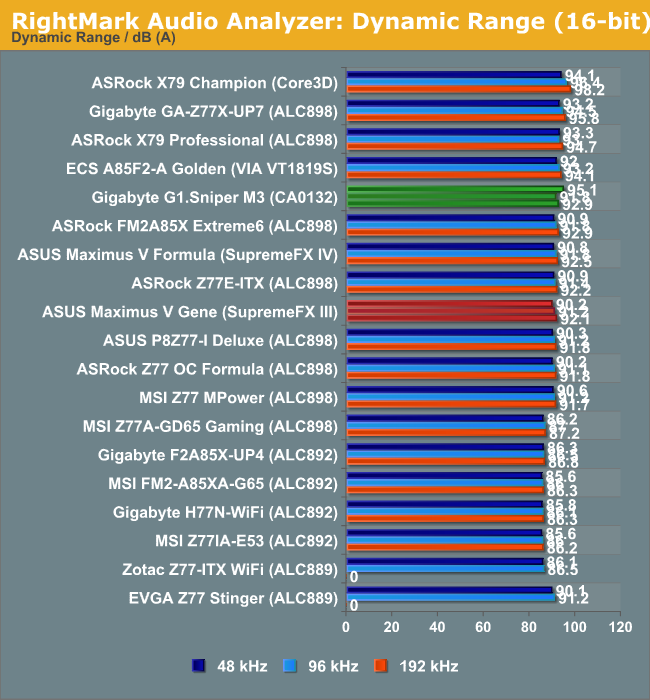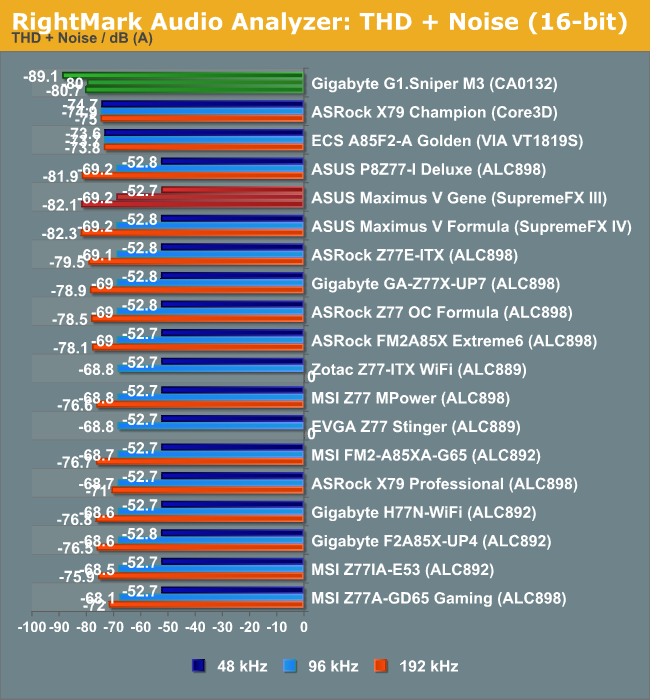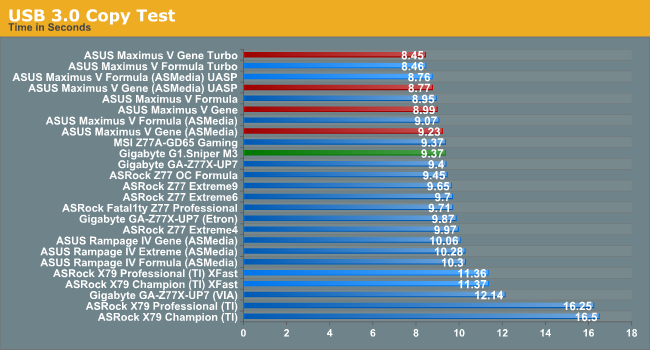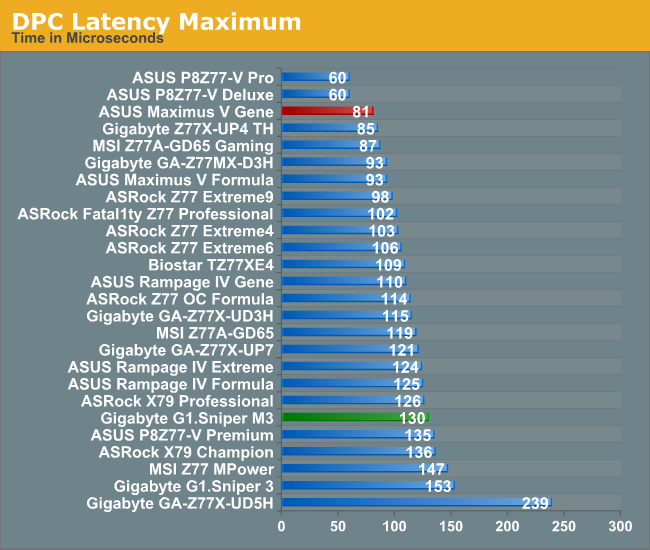ASUS Maximus V Gene vs. Gigabyte G1.Sniper M3 Review
by Ian Cutress on May 13, 2013 10:00 AM EST- Posted in
- Motherboards
- Gigabyte
- Asus
- MicroATX
- Z77
Rightmark Audio Analyzer 6.2.5
In part due to reader requests, we are pleased to include Rightmark Audio Analyzer results in our benchmark suite. The premise behind Rightmark:AA is to test the input and output of the audio system to determine noise levels, range, harmonic distortion, stereo crosstalk and so forth. Rightmark:AA should indicate how well the sound system is built and isolated from electrical interference (either internally or externally). For this test we connect the Line Out to the Line In using a short six inch 3.5mm to 3.5mm high-quality jack, turn the OS volume to 100%, and run the Rightmark default test suite at 48 kHz, 96 kHz and 192 kHz. We look specifically at the Dynamic Range of the audio codec used on board, as well as the Total Harmonic Distortion + Noise.


In our limited audio test, the G1.Sniper M3 does come out better off than the SupremeFX III, but in order to get there we had to disable the majority of the add-in software that comes with the Gigabyte in order to get the test to even run at anything more than 48 kHz.
USB 3.0 Backup
For this benchmark, we run CrystalDiskMark to determine the ideal sequential read and write speeds for the USB port using our 240 GB OCZ Vertex3 SSD with a SATA 6 Gbps to USB 3.0 converter. Then we transfer a set size of files from the SSD to the USB drive using DiskBench, which monitors the time taken to transfer. The files transferred are a 1.52 GB set of 2867 files across 320 folders – 95% of these files are small typical website files, and the rest (90% of the size) are the videos used in the WinRAR test.

The Maximus V Gene is ahead in terms of USB 2.0 speeds and efficiency.

Similarly in USB 3.0, the ASUS takes the lead. As the ASUS has USB 3.0 Boost and an ASMedia controller for extra USB 3.0 ports, we can see that any setting hits the high echelons of our USB 3.0 test. It is worth noting that ASUS have the top eight spots in our most recent USB 3.0 data.
DPC Latency
Deferred Procedure Call latency is a way in which Windows handles interrupt servicing. In order to wait for a processor to acknowledge the request, the system will queue all interrupt requests by priority. Critical interrupts will be handled as soon as possible, whereas lesser priority requests, such as audio, will be further down the line. So if the audio device requires data, it will have to wait until the request is processed before the buffer is filled. If the device drivers of higher priority components in a system are poorly implemented, this can cause delays in request scheduling and process time, resulting in an empty audio buffer – this leads to characteristic audible pauses, pops and clicks. Having a bigger buffer and correctly implemented system drivers obviously helps in this regard. The DPC latency checker measures how much time is processing DPCs from driver invocation – the lower the value will result in better audio transfer at smaller buffer sizes. Results are measured in microseconds and taken as the peak latency while cycling through a series of short HD videos - under 500 microseconds usually gets the green light, but the lower the better.

ASUS typically do very well in DPC Latency, and the Gene is no exception – 81 microseconds was actually a tall peak compared to a baseline around 35-40. Gigabyte’s result required EasyTune6 to be turned off, otherwise the peak was nearer 500 microseconds.










31 Comments
View All Comments
Ristogod - Monday, May 13, 2013 - link
The Title of the article indicates you are comparing the G1.Sniper 3. Instead you use the G1.Sniper M3 in the review.IanCutress - Monday, May 13, 2013 - link
Thanks :) I've had the Sniper 3 on the brain. Though several pairs of eyes have read through and all missed the title.Ian
A5 - Monday, May 13, 2013 - link
I wish manufacturers were more willing to send you cheaper mATX boards.Neither of these boards really feel like a good value compared to cheaper things in the same companies' lines. I guess the ROG makes some sense if you really need the wi-fi card + SLI/XFire (which loses you the Intel NIC as a useful feature...), but still.
IanCutress - Monday, May 13, 2013 - link
It is something I am changing with Haswell. After initial launch reviews, I want to look at mATX. I've let the manufacturers know. That means gaming models and the cheaper end of the spectrum, perhaps in a couple of roundups focusing on price points or individually if people prefer the reviews that way.Ian
A5 - Monday, May 13, 2013 - link
I personally like round-ups better due to the fact that they make the writer make explicit comparisons, but I understand that they're way more work for you :PEither way I'll probably upgrade before it would be published, but I appreciate the idea of increasing coverage in that segment.
DanNeely - Monday, May 13, 2013 - link
I'm probably going to hold off until the USB3 fix refresh is out; so I should be able to read all the initial wave reviews before opening my wallet. My main box is going to be high OCed and water cooled; so I assume the boards I'm interested in will be in the initial flagship/near flagship review wave.MrSpadge - Tuesday, May 14, 2013 - link
Agreed - at these prices I wouldn't consider such mainboards at all.just4U - Tuesday, May 14, 2013 - link
A5, I don't see them as a good value compared to cheaper boards in the same company. My view has always been (with gaming matx) they are a great value when compared to more expensive boards in the same company. They pack a lot into these little boards /w features typically only seen in their highest end offerings.GeorgeH - Monday, May 13, 2013 - link
I had the Gene for about a week before replacing it. It was an awesome board, I just couldn't stand the coil whine. Sample size of 1, though, so did you notice any whine with your review sample?IanCutress - Monday, May 13, 2013 - link
No coil whine on my sample. I notice that some motherboards cause my testing PSUs to whine every now and again, especially in multi-GPU setups on gaming tests, but I can't say I had any with the Gene.Ian